-
info@aaanimalcontrol.com
Call us for help in your town
Humane Wildlife Education
Do snakes always inject venom when they bite?
Do snakes always inject venom when they bite?
Need snake removal in your hometown? We service over 500 USA locations! Click here to hire us in your town and check prices- updated for year 2020.
Believe it or not, there aren't that many venomous snakes out there. There are far many more non-venomous species than there are venomous ones. To make things even more confusing, not all venomous snakes are actually that dangerous to humans. The trouble is that you don't always know just by looking at the snake. Some snakes will mimic the colors or patterns of a venomous snake just to make itself look more scary to passing predators. It would be very easy to assume that a non-venomous snake was a venomous one, which isn't a bad thing. Keeping your distance from any snake species is smart. But what happens when a human confuses a venomous snake with a non-venomous one? Believing the snake to be “safe”, getting too close could result in a nasty bite. One bite could be all it takes to inject lethal amounts of toxic, potent venom in some cases, and that one bite could even prove to be fatal.
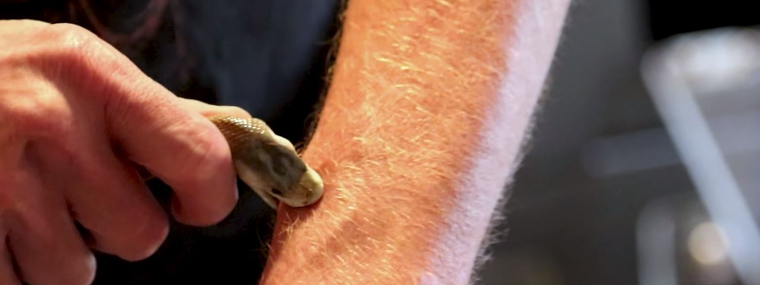
The most venomous snakes in the world are the Inland Taipan, Eastern brown snake, yellow bellied sea snake, Peron's sea snake, coastal taipan, many-banded krait, black-banded sea krait, black tiger snake, Western Australia tiger snake, and the beaked sea snake. None of those snake species are found in North America, instead scattered over Australia, China, Vietnam, Taiwan, and tropical oceanic waters.
You've also got the Black Mamba, which is not only highly-venomous, but also rather large. The Indian Cobra is another dodgy snake to be around, but fast treatment often prevents fatalities in humans. Vipers are well known to have some of the most painful snake bites out of them all, with venom of lethal potency too. Again, these are not snakes that you are likely to come across in your own back yard.
Snake bites are actually not easily documented, as it is believed that many of them actually go without being reported. It is reported that fewer than eight thousand people are bitten by snakes each year in the United States, and this amounts to 1 in 37,000. The chances of you dying from that snake bite? 1 in 50 million.
You've got more chance of being hit by lightning than you have being bitten by a venomous snake in the United States. You're nine times more likely to get hit by lightning, in fact.
The venomous snakes that you will find in North America include:
- Rattlesnakes
- Coral snakes
- Cottonmouths (also known as water moccasins)
- Copperheads (also known as highland moccasins)
It is the last one — the copperhead or highland moccasin snake — that seems to be the biggest culprit, accounting for almost forty percent of all snake bites from a venomous species across the US.
In the majority of cases, you won't even know that you have come anywhere close to a venomous snakes. Many of them are actually rather shy and would much prefer to slither away, than stay and fight whatever is coming its way. (Unless that something is prey, of course.) They will use their toxic venom as a last resort in most cases, and only when their regular defense mechanisms have been exhausted. In the case of the rattlesnake, it is that undeniable rattle sound.
Not all snakes inject venom when they bite, but a few of them do. Those are the ones that you want to steer well clear of. That's not to say that you can get close to the non-venomous species, however. If you don't know what species you're looking at, it could be venomous or non-venomous, giving you a 50/50 chance of getting seriously hurt. Either way, snakes can and will snap and bite if you provoke them enough, and that can be said for even the most docile of snake species. You should not approach a snake in the wild, whether you believe it to be non-venomous or not.
How to tell if a snake is venomous
Need snake removal in your hometown? We service over 500 USA locations! Click here to hire us in your town and check prices- updated for year 2020.
No matter where you live in America, you have a very good chance of coming across some form of venomous snake at some point. While most of us think of the snakes as existing in desert regions, there are several different kinds that live along the swamps and rivers in areas of the country. You also have the concern that people take these deadly creatures to wherever they live, realize that they can't take care of them properly, and let them go near a park or other wild life location. This opens the door to you seeing a venomous snake even in an area like Montana or Maine.
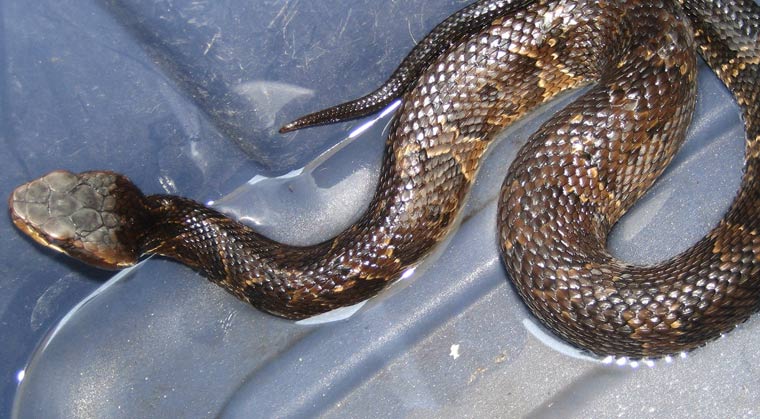
The problem for most people is that they would have not the slightest idea of whether a snake was venomous or not. They don't know what to look for, or even if there are signs that will let you know that a snake is poisonous in this way. Fortunately, there are ways to tell, and so here is how to tell if a snake is venomous.
The first way is by knowing a little bit about the different kinds of venomous snakes that are in the United States. There are only four different types, the cottonmouth, the rattlesnake, the copperhead, and the coral snake. Being able to distinguish depends on your knowledge of these four kinds of snakes.
In the cottonmouth snake, you will find that these snakes have pupils that are elliptical in shape and that their colors range from black to green. Along the side of their head you will find white stripes, and they are directly found around sources of water. The cottonmouth is often referred to as a water moccasin for this reason. One thing you can be sure of is that if you see two snakes together that look like cottonmouths then they are not so. These are loners, and are never seen together in that way.
The rattlesnake is easily distinguishable because of the rattle that is on the end of its tail. Some nonvenomous snakes will try to imitate this behavior to deter other animals from approaching them, but there is no faking the way the tail looks. If you see this then you know you need to back away.
The copperheads look very much like a cottonmouth, except for the fact that their colors are much brighter. You will usually see such things as a copper colored brown or a bright orange. Some can even look pink or peach colored. The younger of the species often have yellow tales to them. It is the bright colors, however, that really let you know you may be looking at a copperhead.
The last of these is the coral snake. These snakes have a very distinctive coloring pattern, with bands of black, red, and yellow. They will also have a yellow colored head, and black bands that go around their nose. This is a very distinctive look, that only one other kind of snake, the non-venomous milk snake, has. If you see it, you should assume you are looking at a coral snake just to be on the safe side.
Need snake removal in your hometown? We service over 500 USA locations! Click here to hire us in your town and check prices- updated for year 2020.
Snakes produce venom using glands that seem to have evolved from a type of salivary gland around 170 million years ago — the same kind of salivary glands that humans have. In human saliva, you will find enzymes present that help to break down food items when you chew it, making the digestion process a lot easier. Snakes have a tough time chewing food, however, many of them devoid of teeth. For those snakes that don't chew their food, salivary glands have been taken over with a gland that produces a toxic fluid instead — the venom.
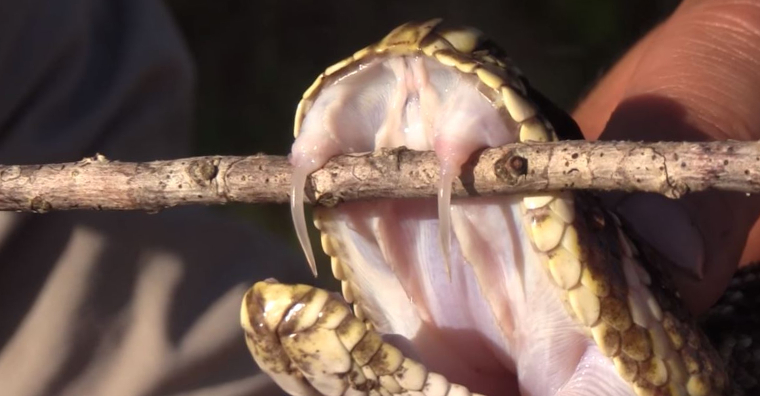
Different snake species product venom that has different effects. When the venom of these creatures have been studied, the cells that are contained within them are only slightly different from the enzymes that make up saliva in various animals that does the digestion-aiding job. The toxicity would have grown and evolved over time, no doubt, with the possibility that some of their prey victims could even have become immune to the venom, much in the same way that antibiotics can start to have little or no effect on the bugs they were designed to treat. The bugs develop an immunity, usually over time, and then mutate further, preventing the follow-up disease from being easily treated.
Some snakes will inject a venom that prevents your blood from clotting. There are others that will inject you with toxins that stop you from being able to send and receive signals from the brain, essentially paralyzing you and allowing you to be consumed. It would take a pretty big snake to overcome and then feast on an adult male of course, but if a highly venomous snake were to bite and inject a child with their powerful toxins, it wouldn't be too much of a tough task. The same can be said for pet cats and dogs too.
Vipers are perhaps the worst of all venomous snakes, if you could determine one particular type or species as “the worst”. These snakes have venom delivery tools that are highly developed, with long fangs to help penetrate skin and flesh, plus a highly potent venom that can present great pain, alongside a range of other unpleasant symptoms. The blood won't be able to clot, the blood pressure drops dramatically, which is what will end up probably killing you, if the anti-venom isn't administered fast enough. The muscles will contract and paralysis could occur. The venom might not prove to be fatal in all cases, but the bite and subsequent symptoms are incredibly unpleasant and known to be very painful.
It is not always immediately obvious which species of snake are venomous, so it must be assumed that all snakes you come across are dangerous until proved otherwise. Just one bite is all it takes for the powerful venom to be delivered, and if you believe (incorrectly, perhaps) that you have been bitten by a non-venomous snake, you might not even seek medical treatment at all, which makes the plight all the more dangerous.
How to Tell is a Snake is Venomous
Need snake removal in your hometown? We service over 500 USA locations! Click here to hire us in your town and check prices- updated for year 2020.
There are actually a few ways in which you can determine the difference between venomous snakes and non-venomous snakes, although we wouldn't exactly recommend that you get close enough to find out for yourself. What happens if you were to get up close and personal with a venomous snake, believing it to be a safe one, and only learn too late that it's not? You should also remember that there are a lot of different snake species out there, and each of them have a very wide range of designs, styles, shapes and colors, as well as thickness and length, which can make working out what kind it is rather difficult.
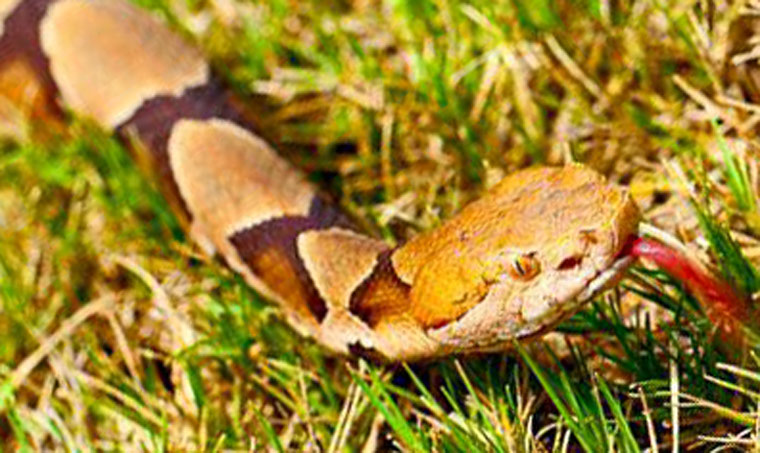
Don't take the chance. Walk away from a wild snake, just in case.
There are quite a few myths out there surrounding the whole venomous/non-venomous snake debate, and one that you should definitely not pay attention to is the one that dictates all venomous snakes have heads shaped like triangles.
Almost ALL species of snake have triangular-shaped heads, both venomous and non-venomous. The pit viper is a species of venomous snake that does have a very, very triangular shaped head, more broader and flatter than other species, but that's just ONE species of venomous snake.
Another myth that we've heard is that all venomous snakes have bright and vibrant patterns. Again, don't pay attention to this. So many snakes have bright and vibrant patterns now that you just can't rely on it to work out the venomous species. Although we do agree that you should treat every snake you come across as venomous until it can be 100% proved otherwise.
There IS a song that this myth DOES apply to:
“Red touch yellow, kills a fellow. Red touch black, friend of Jack.”
This rhyme applies to a type of venomous snake — the coral snake — and a few different other species of non-venomous snake that dress up as the coral snake to appear more threatening than it actually is. The scarlet king snake is the more believable, but there are a few others too.
When the red stripes touch the yellow stripes (are next to them) on the pattern on the snake, there's a good chance you're facing a very dangerous and venomous coral snake. If the red stripes touch the black stripes, however, it's not venomous.
Some venomous snakes DO have certain traits in common, although these generally require you getting quite close to find out more. We don't recommend this.
If you can see the snake's pupils, note whether they are found or more elliptical/cat-eye shaped. Venomous snakes tend to have elliptical pupils, whereas non-venomous snakes have round pupils.
The rattle of a tail isn't always an indication that you're facing a venomous snake, but if you can hear it, back away. There are plenty of snake species who rattle their tails when they feel threatened, but only the infamous rattlesnake makes that familiar rattle-like noise.
Finally, one final trait that most venomous snakes tend to have in common is that they are very thick-bodied. This is not a definite indication, however, and we would always suggest finding out from an expert before you make a final decision.
Do snakes run out of venom?
Need snake removal in your hometown? We service over 500 USA locations! Click here to hire us in your town and check prices- updated for year 2020.
Snakes have shown themselves to be very adaptable creatures, with over 2,700 species, each with their own unique abilities and features. Venom is just one of those evolving features, essentially only a few protein compounds different from the saliva found in our own human mouths. The venom, just like our saliva, isn't entirely endless, however. In the same way that a skunk would need some time to build up spray reserves after a period of heavy spraying, snakes would need a while to recover and re-build those stores of venom, especially if the venom has been used in copious amounts over a shorter period of time.
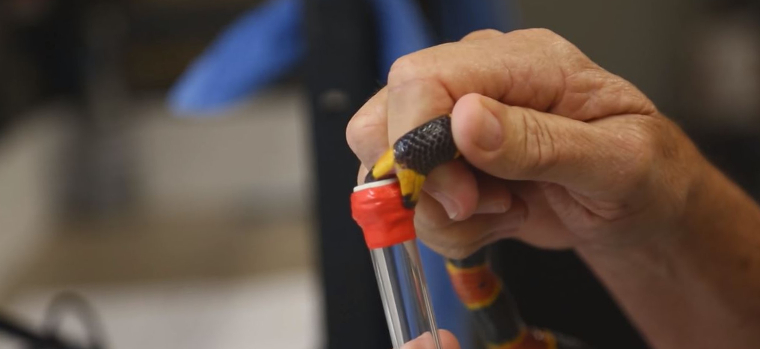
Not all prey will need the same amount of toxic venom. Smaller creatures, such as rodents, would only need a small amount of the snake's reserves. Let's give a rough estimate of 10% of the snake's venom store. Larger prey would need more of the toxin to overpower them. Again, let's give a rough estimate of around 50%. If the snake were to use it's venom to ward off a larger predator, using 50% of its venom, plus another 10% on a prey animal, there would only be 40% of it left. Over time, say a few days or weeks, the venom would gradually build up. That forty percent would turn into fifty percent after a day or so, perhaps, and then sixty percent the day after. This is all the time the snake doesn't use its venom again. If it does, the tank would just deplete once again .The snake is capable of constantly producing the toxic stuff, but it would need some time to recover after a series of venomous bites.
It must be remembered that you won't be able to tell how much venom is in a snake's stores just by looking at it. Sometimes, it's not even possible to work out the actual species of the snake from the patterns and markings alone. There are venomous snakes that look very much like non-venomous snakes, and there are even non-venomous snakes that mimic the look of those with a toxic bite. It is very easy to confuse the two.
Venomous snake vs poisonous snake
Need snake removal in your hometown? We service over 500 USA locations! Click here to hire us in your town and check prices- updated for year 2020.
For something to be poisonous, you need to ingest it. Poisonous berries, for example, are not usually poisonous to touch, but when you eat them they can make you feel quite ill. In some instances, eating something poisonous can be deadly.
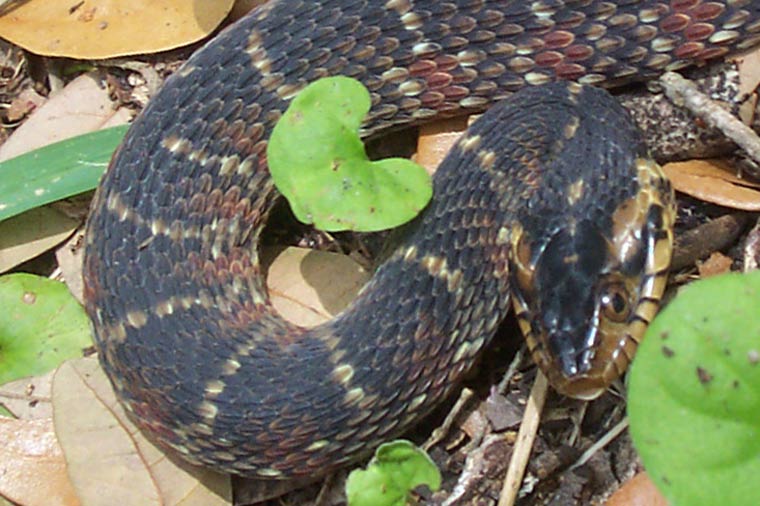
A snake would need be ingested for it to be poisonous to you. Are you planning on eating a snake? We definitely aren't. We probably wouldn't recommend it, and definitely not if you wouldn't know the difference between a venomous and a non-venomous snake.
Snakes, if they are going to be “dangerous” are not poisonous, but venomous. Snake venom is a type of saliva that contains a compound that allows for the snake to stop the prey in its tracks, entirely immobilize it, and even help the snake to digest it.
Most snakes will require a bite for the venom to be injected into their prey. They have special fangs for this, and they will vary from species to species. Some snakes can actually spit their venom at you, the spitting cobra being one of them ... and aptly named! Luckily, these spitting cobras are not found in the USA, instead found in Asia and Africa.
There are quite a few venomous snakes found across North America, which sounds like a really high number but shouldn't alarm you too much. There are some snakes with venom that isn't potent enough to harm a human too much, mostly causing some discomfort. The pygmy rattlesnake is a classic example of this, a snake that only grows to a maximum of 24 inches. The bite and venom can cause some nasty irritation, but is generally not fatal / life-threatening.
One of the most potent venoms found in any USA snake is injected from the fangs of the yellow belly sea snake. Despite having one of the most dangerous venoms that is certainly capable of killing a man, it very rarely leaves its watery habitat. You'll find these in tropical oceanic waters, but you won't spot it in the Atlantic Ocean. It's one of the most widely-distrusted snakes across the globe, but there have been no reports of a human being killed after a bite. Luckily, this one tends to keep itself to itself … in the water.
Believe it or not, there aren't actually that many snake bites reported each year. The number sounds quite high, but when you bear in mind that many of these will be non-venomous snake bites, and in most situations, the human would have aggravated the snake to make it snap back with a bite. Many of these snakes need time to replenish their venom supplies, so they won't want to waste any of it on someone or something that doesn't need it.
One to two thousand snake bites is believed to be the average, per year, across the United States of America. Less than five of those 1,000 - 2,000 bites will end up being fatal. The advances in medicine and technology has made it easier to create anti-venom for these dangerous bites.
The Eastern coral snake, Western coral snake, Texas Coral snake, Eastern diamondback rattlesnake, Western diamondback rattlesnake, Eastern and Western copperhead snakes, the copperhead snake, cottonmouth snake, Mojave rattlesnake, Massasauga rattlesnake are all classed as venomous snakes found in the US.
If you have been bitten by a snake, seek medical advice It is not always easy to tell whether the snake is venomous or not just by looking at it. If you don't know your snake species, there's a good chance you wouldn't know what the snake was, let alone whether or not the bite could be fatal.
For more information, you may want to click on one of these guides that I wrote:
How much does snake removal cost? - get the lowdown on prices.
How to get rid of snakes - my main snake removal info guide.
Example snake trapping photographs - get do-it-yourself ideas.
Snake job blog - learn from great examples of snake jobs I've done.


















